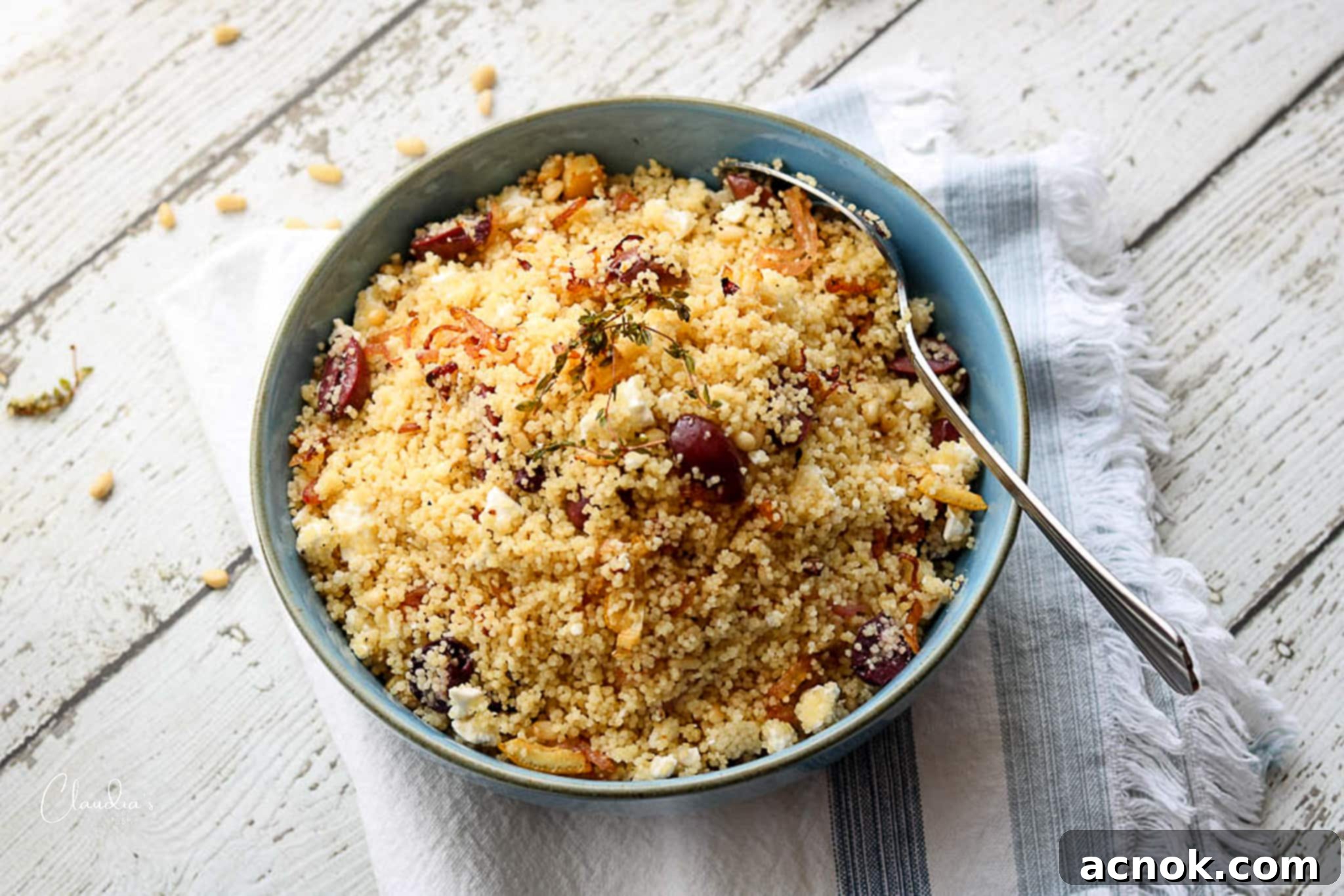Lemon Thyme Couscous with Olives & Feta: Your Zesty Mediterranean Side Dish
Elevate your meal with this incredibly fragrant and vibrant Lemon Thyme Couscous with Olives and Feta. It’s the ultimate quick and easy side dish, perfect for complementing grilled chicken, tender lamb, or flaky fish. While plain couscous is often a convenient go-to, learning to infuse it with robust flavors is key to truly enjoying it. Our recipe does just that, transforming a simple grain into a gourmet experience. We build on couscous’s natural simplicity by adding aromatic sautéed shallots, bright lemon zest and juice, fresh thyme, crunchy toasted pine nuts, creamy feta cheese, and savory Kalamata olives. This delightful dish is not only a fantastic option for busy weeknights but also elegant enough to impress guests at your next dinner party, offering a burst of Mediterranean flavors with every bite.
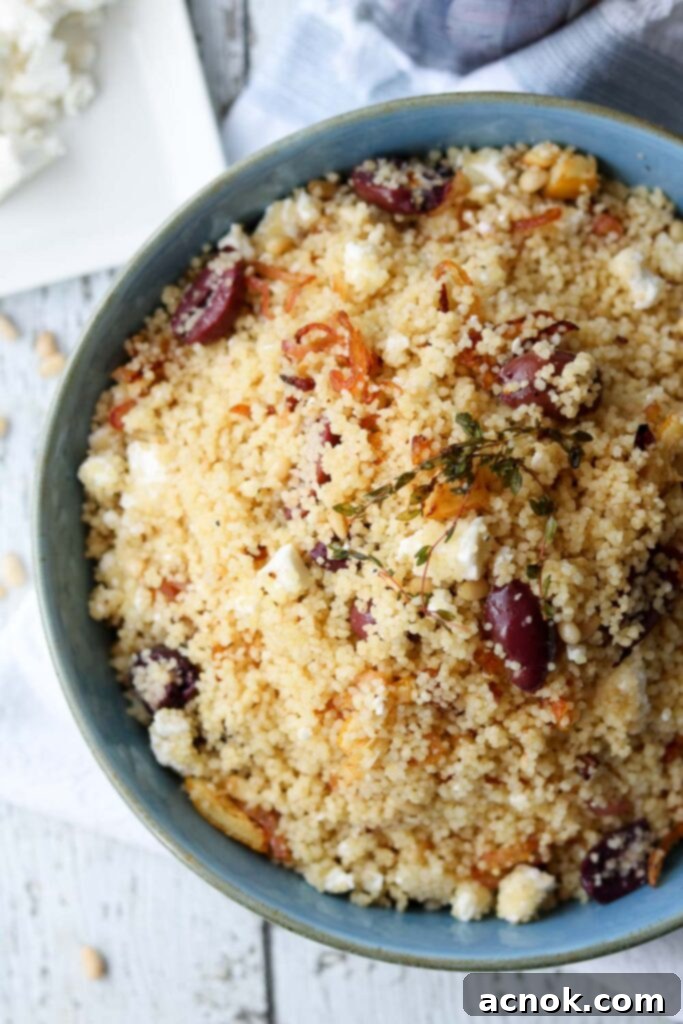
Crafting the Perfect Couscous: A Flavorful Mediterranean Foundation
As a devoted fan of quick and versatile ingredients, I often turn to couscous for its incredible ability to serve as an ideal canvas for a multitude of flavors, colors, and textures. Its undeniable ease of preparation – cooking in a mere five minutes – makes it an absolute champion for speedy weeknight dinners. However, plain couscous can sometimes be, well, plain. This recipe aims to elevate it from a simple accompaniment to a truly unforgettable dish. We start by building a robust flavor base, gently sautéing thinly sliced shallots, fragrant lemon pieces (using both the juicy flesh and aromatic rind), and fresh thyme sprigs in rich extra virgin olive oil. This meticulous process not only softens the shallots and releases their delicate sweetness but also deeply infuses the olive oil with bright citrusy and earthy herbal notes, creating an incredibly aromatic foundation for our couscous.
The beauty of this Mediterranean-inspired dish lies in its exquisite balance of flavors and textures. We combine the warm, aromatic olive oil mixture with fluffy, perfectly cooked couscous, then carefully stir in crunchy toasted pine nuts, salty crumbled feta cheese for a creamy tang, and briny Kalamata olives for that essential Mediterranean punch. The resulting flavor profile is wonderfully bright, fresh, and complex, making each forkful a delight. One of the most convenient aspects of this recipe is its versatility: it’s equally delicious served warm right after preparation or at room temperature, making it incredibly flexible for meal prep, potlucks, or sophisticated entertaining. This dynamic side dish is sure to become a beloved staple in your culinary repertoire, impressing with its simplicity and depth of flavor.
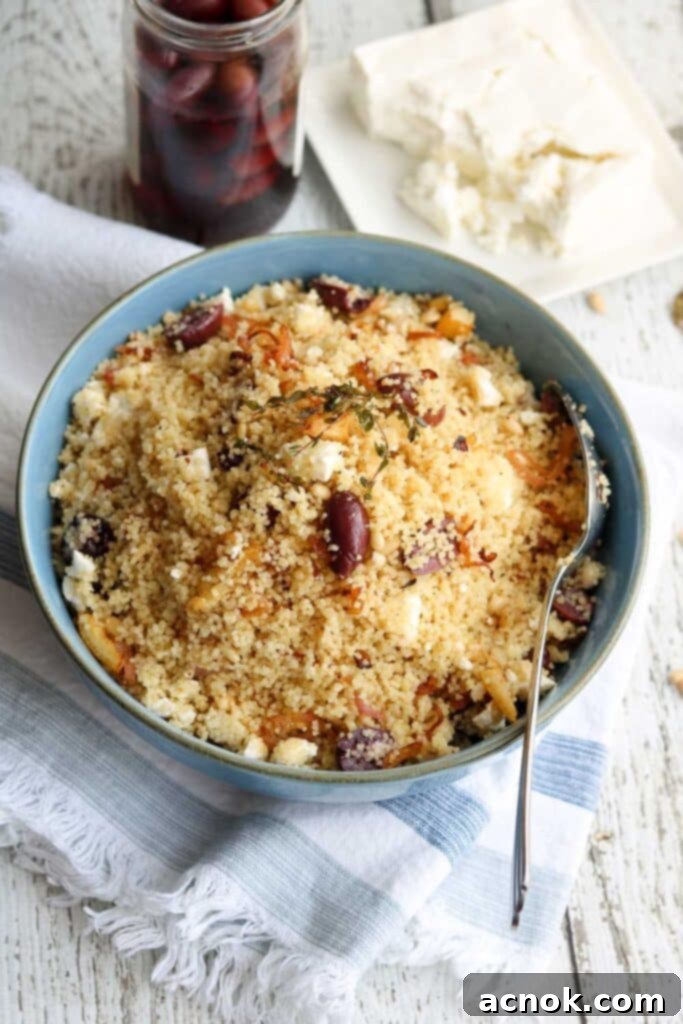
The gentle sautéing of shallots, lemon pieces, and thyme in extra virgin olive oil is a critical step that cannot be overlooked. As these exquisite ingredients slowly release their essences, they don’t just cook; they imbue the olive oil with a delightful depth of flavor and a captivating aroma that will fill your kitchen with enticing scents. While we personally enjoy the soft, slightly caramelized lemon pieces in our finished dish for an extra burst of concentrated citrus, you always have the option to remove them, along with the thyme sprigs, before incorporating the remaining ingredients. For optimal results and a truly light and fluffy texture, we highly recommend using the tiny Moroccan couscous, which absorbs flavors beautifully, rather than the larger, chewier Israeli type. If you need a refresher on preparing perfectly fluffy couscous, or are cooking it just before making this recipe, you can refer to our detailed post on how to cook couscous perfectly every time. This particular recipe assumes you have your couscous cooked and ready, allowing you to focus on building these incredible, vibrant flavors that define our Lemon Thyme Couscous.
Essential Ingredients for Your Lemon Thyme Couscous with Olives
Crafting an exceptional dish begins with selecting high-quality ingredients. Here’s a detailed look at what you’ll need to make this vibrant Lemon Thyme Couscous, along with a note on why each component is vital:
- 3 cups of cooked couscous: Ensure it’s the small, quick-cooking Moroccan variety for the best light and fluffy texture. (As a guide, 1 cup of dry Moroccan couscous typically expands to yield about 3 cups once cooked).
- 1 large shallot, thinly sliced: Shallots provide a delicate, sweet onion flavor that is much milder and more nuanced than regular onions, making them ideal for this bright side dish.
- 1/4 cup lemon slice pieces (flesh and rind): Utilizing both the juicy flesh and the aromatic rind ensures we capture the maximum bright, zesty, and complex lemon flavor, which is a cornerstone of this recipe.
- 2-4 fresh Thyme sprigs: Fresh thyme contributes an earthy, slightly peppery, and highly aromatic note that beautifully complements the citrus. Use 2 large sprigs for a more pronounced herbal presence or 4 smaller ones for a subtle infusion.
- 3 tbsp extra virgin olive oil: A good quality extra virgin olive oil is indispensable. It’s used for sautéing the aromatics and coating the couscous, adding a rich, fruity base and a characteristic Mediterranean essence.
- 2 tbsp pine nuts, toasted: These small, buttery nuts are crucial for adding a delightful, slightly sweet flavor and a satisfying textural crunch. Toasting them properly deepens their nutty aroma significantly.
- 1/3 cup feta cheese, crumbled: Crumbled feta cheese brings a wonderful salty, tangy creaminess that truly ties all the vibrant Mediterranean flavors together, adding a rich depth.
- 1/3 cup Kalamata olives, sliced: These distinctive Greek olives contribute a briny, fruity, and subtly smoky depth that is absolutely indispensable and characteristic of the Mediterranean profile in this recipe.
- Salt and freshly ground black pepper: To taste, for seasoning and enhancing all the natural flavors.
The Simple Secret to Delicious Pine Nuts: Toasting Them Perfectly
Toasting pine nuts is a quick yet crucial step that dramatically elevates their flavor, transforming them from merely pleasant to wonderfully nutty, buttery, and incredibly aromatic. To achieve this, select a dry stainless steel or non-stick pan and preheat it over low to medium-low heat. Add the pine nuts in a single layer and sauté them gently for just 1-2 minutes, stirring them frequently to ensure even browning. Keep a very close eye on them, as pine nuts have a high oil content and can go from perfectly golden and fragrant to burnt in a matter of seconds. Once they reach a beautiful light golden color and release their irresistible aroma, immediately remove them from the hot pan and spread them out on a plate to cool. This quick cooling step stops the cooking process and prevents any further browning or burning. The slight crunch and intensely deepened flavor they develop will make a noticeable and delightful difference in your couscous.
Easy Step-by-Step Instructions: Assembling Your Lemon Thyme Couscous
This wonderfully fragrant and lemony couscous comes together with surprising ease, building a base that’s bursting with Mediterranean flavor in just a few simple minutes. Follow these clear, step-by-step instructions to effortlessly bring all the delicious components of this side dish together:
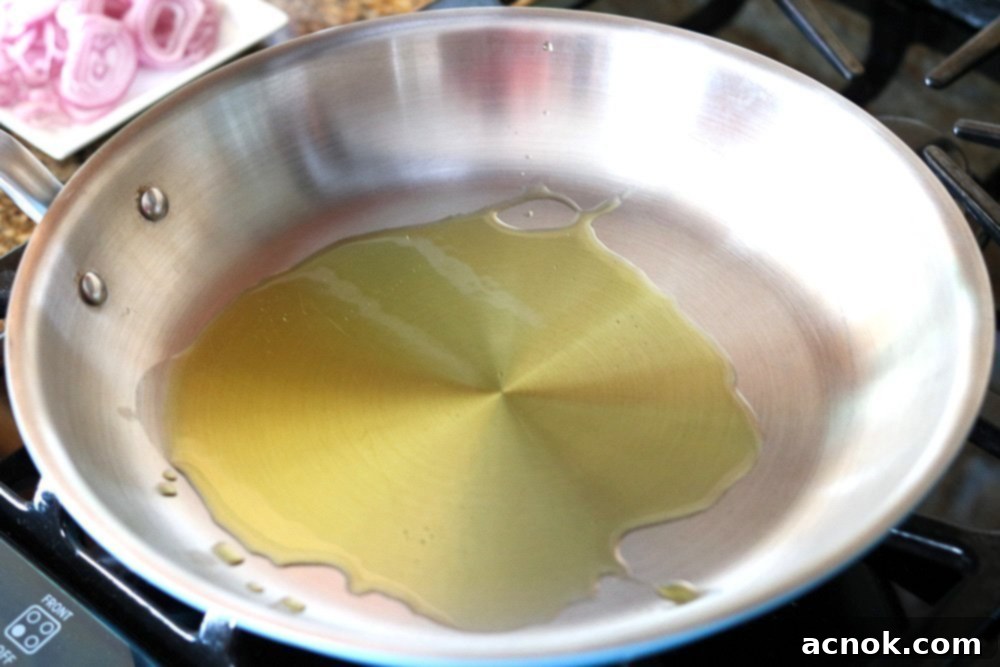
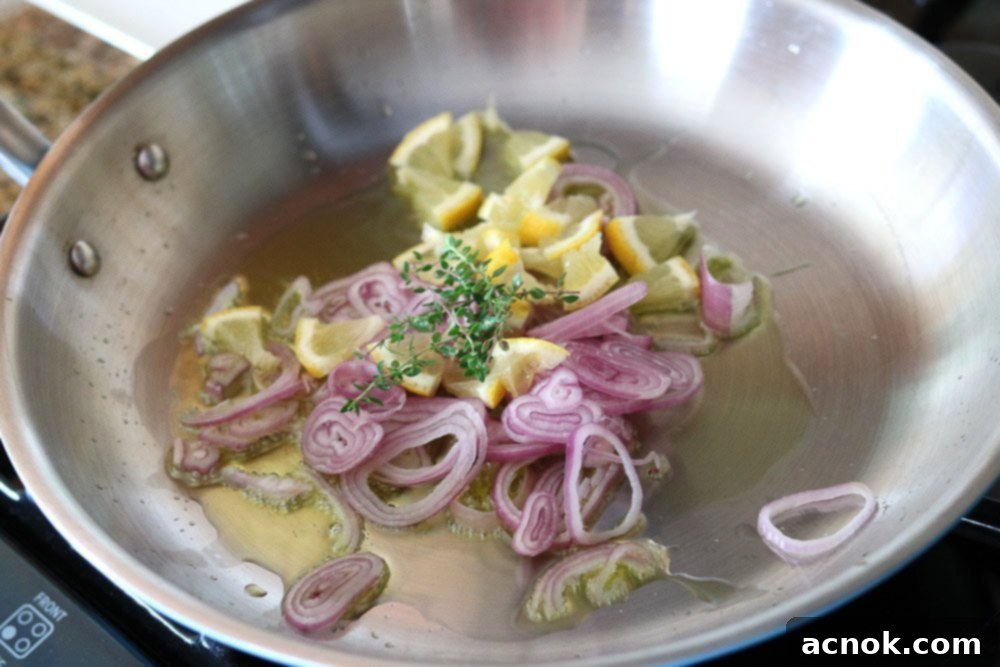
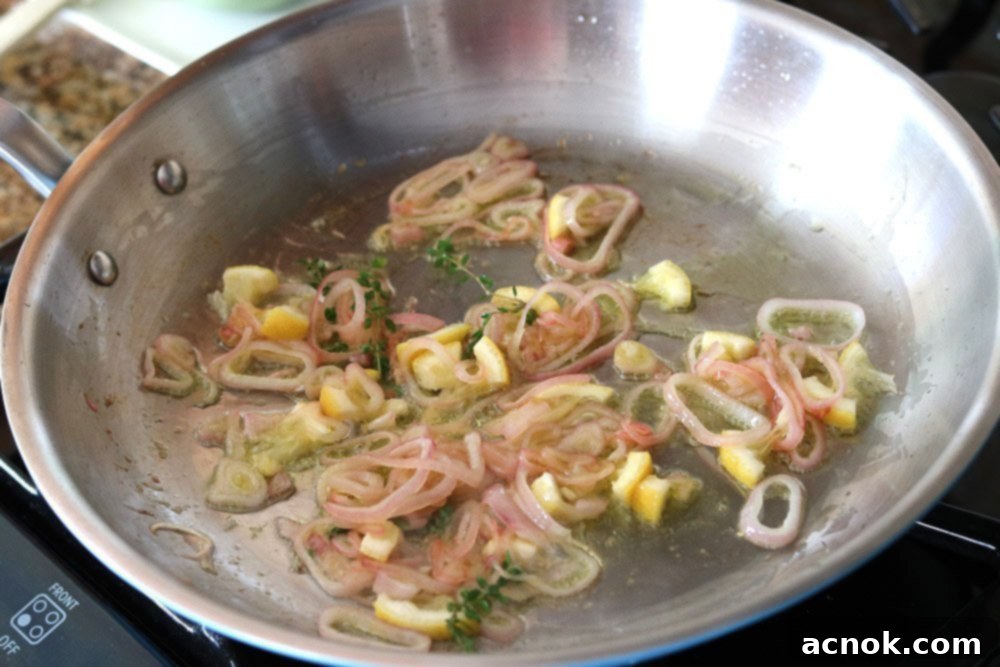
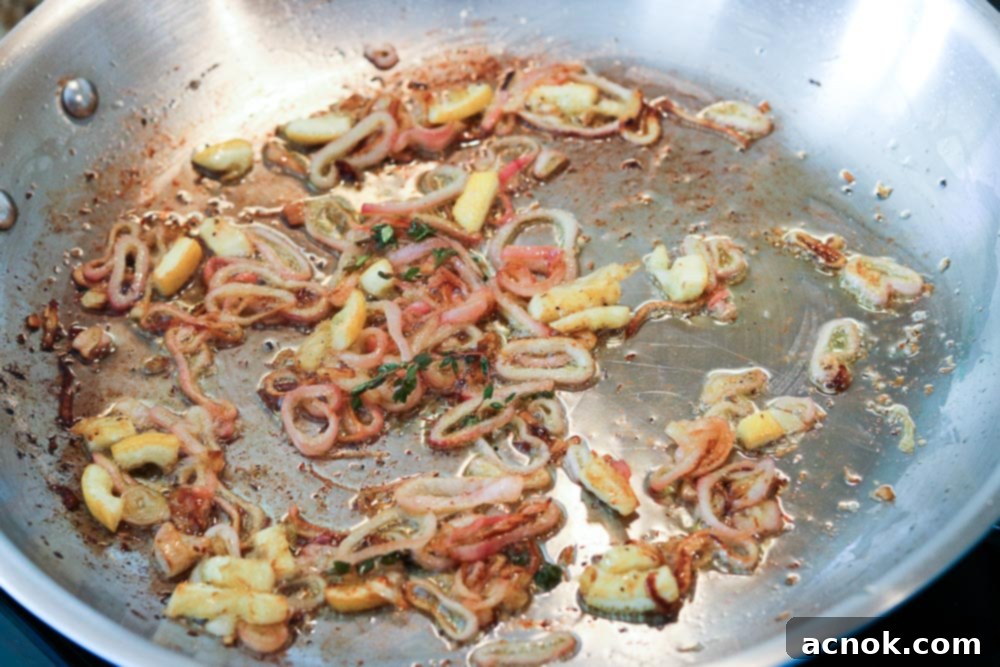
Once your aromatic mixture is perfectly cooked and beautifully fragrant, it’s time for the final, simple step of bringing everything together. Add the prepared, fluffy cooked couscous directly into the skillet with the infused olive oil, sautéed shallots, and any remaining lemon pieces. Then, gently fold in the crumbled feta cheese, the crunchy toasted pine nuts, and the sliced Kalamata olives. Toss all the ingredients together with care until everything is well combined, ensuring the couscous is evenly coated with the flavorful oil and the other ingredients are uniformly distributed throughout. Take a moment to taste and adjust the seasoning with additional salt and freshly ground black pepper as needed. A final squeeze of fresh lemon juice at this stage can further brighten and enhance all the wonderful flavors. This Lemon Thyme Couscous with Olives is absolutely delicious served warm or, for an even richer melding of flavors, at room temperature. Enjoy this vibrant Mediterranean side dish!
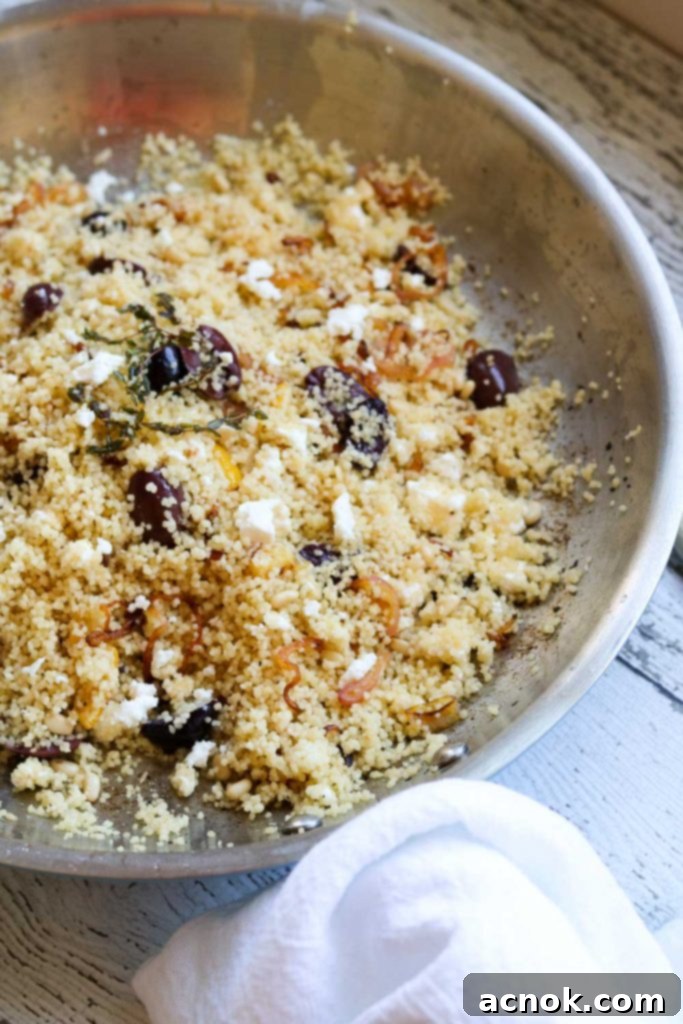
I absolutely adore this side dish! Its bright, fresh, and distinctly Mediterranean flavors make it an incredibly versatile companion for so many main courses. It’s the perfect accompaniment for classics like a Simple Herb Roast Chicken, delicate Salmon with Garlic Lemon Sauce, flavorful Grilled Lemon Oregano Chicken with Salmoriglio Sauce, or a succulent Pork Tenderloin with Lemon Herb Pan Sauce. Beyond dinner, I often transform any leftovers, or even a fresh batch, into a quick, healthy, and incredibly satisfying weekday lunch by simply adding shredded rotisserie chicken, a handful of protein-rich chickpeas, or even some grilled vegetables. This Couscous with Lemon Thyme and Olives is truly a dish that keeps on giving, offering both convenience and gourmet flavor with minimal effort.
Creative Customizations and Handy Tips for Your Couscous
One of the greatest joys of home cooking is the freedom to customize and experiment with recipes. This Lemon Thyme Couscous with Olives is incredibly adaptable, allowing you to easily swap ingredients to suit your personal taste preferences, dietary needs, or simply what you have on hand. Here are some fantastic suggestions and tips to inspire your culinary creativity and make this dish uniquely yours:
- Fresh Mozzarella & Prosciutto Twist: For a delightful Italian-inspired flavor profile, you can entirely change the character of the dish. Instead of feta, olives, and thyme, sauté only the shallots as directed. Then, finish the dish by tossing it with fresh, creamy mozzarella pearls or diced fresh mozzarella, thinly sliced strips of savory prosciutto, fragrant fresh basil leaves, and sweet, juicy cherry tomatoes. A light drizzle of high-quality balsamic glaze can add an extra layer of gourmet complexity.
- Olive Alternatives: While Kalamata olives are highly recommended for their distinct briny and fruity notes, feel free to experiment with other varieties if you prefer. Bright green, buttery Castelvetrano olives offer a milder, slightly sweeter contrast, or you could use a vibrant mix of various Mediterranean olives for an interesting medley of flavors and colors.
- Cheese Swaps: If the tang of feta isn’t quite to your liking, there are excellent alternatives. Try swapping it for finely shredded Parmesan cheese, which will introduce a saltier, nuttier, and more umami flavor profile. Alternatively, soft goat cheese could add a creamy, more piquant touch, or even a firm, grated provolone for a different Italian twist.
- Onion Variations: Red onion, thinly sliced and gently sautéed until translucent, can be an excellent substitute for shallots. It offers a slightly sharper and more pungent flavor when raw, but mellows beautifully when cooked, providing a delicious aromatic base. Sweet onions could also be used for a milder, more caramelized effect.
- Nutty Additions: While pine nuts provide a unique buttery flavor and delicate crunch that I highly recommend for this dish, you can certainly experiment with other toasted nuts. Toasted walnut pieces would add an earthy, slightly bitter note, while blanched and toasted hazelnuts would offer a richer, more robust flavor and a satisfying crunch. Almond slivers could also work well for a subtle, sweet nuttiness.
- Herb Explorations: Don’t limit your creativity to just thyme! Fresh oregano can lend a classic Greek aroma, finely chopped fresh dill can add a bright, almost lemony freshness, or even a touch of finely chopped fresh mint could introduce an intriguing cool and vibrant dimension to the dish, especially delightful in warmer weather.
- Vegetable Boost: Enhance the nutritional value, visual appeal, and textural variety by incorporating additional fresh vegetables. Finely diced cucumber, colorful bell peppers (red, yellow, or orange), or tender sun-dried tomatoes (rehydrated if packed dry) can be gently folded into the couscous during the final mixing stage for an extra layer of freshness and crunch.
- Citrus Kick: For an extra burst of zest, grate a little fresh lemon zest over the finished dish just before serving. This brightens the entire flavor profile without adding extra liquid.
Storing and Reheating Your Delicious Couscous
This vibrant Lemon Thyme Couscous recipe is not only delicious fresh but also fantastic for meal prepping, as it stores beautifully in the refrigerator. You can easily prepare a larger batch and enjoy it for several days to come! Store any leftover Lemon Thyme Couscous with Olives in a clean, airtight container in the fridge for up to three days. You might even find that the flavors meld and deepen overnight, often making it even more delicious the next day, as the couscous fully absorbs all the aromatic oils and seasonings.
To reheat, for individual or smaller portions, simply place the couscous in a microwave-safe dish and heat for 20-30 seconds at a time, stirring gently halfway through, until it’s warmed through to your liking. Be cautious not to overheat, as couscous can dry out quickly. For larger quantities or if you prefer the stovetop method, transfer the couscous to a non-stick skillet over medium-low heat. To help rehydrate and prevent sticking, add a splash of chicken or vegetable broth (or even just water) and a tiny drizzle of fresh olive oil. Warm it gently, stirring occasionally, until thoroughly heated. This method helps maintain its wonderfully fluffy texture and prevents it from becoming clumpy or dry.
If you’ve fallen in love with the versatility and flavor of couscous through this recipe, be sure to explore some of my other delightful creations. You might enjoy the elegant Rosemary Lemon Rack of Lamb with Couscous, the rich and savory Couscous with Caramelized Onions and Feta, or the exotic and flavorful Chicken Thighs with Za’atar, Carrots and Currants. Each offers a unique way to enjoy this fantastic grain!
If you tried and loved this recipe, please consider helping other readers discover it by commenting below and sharing some stars! Your feedback and ratings mean the world to us and help our community grow. We 🫶🏼 sincerely appreciate you!
All content and photographs ©Claudia’s Table and claudiastable.com

Lemon Thyme Couscous with Olives
Ana | Claudia’s Table
September 1, 2020
Pin Recipe
Equipment
-
Saute Pan
Ingredients
- 3 cups couscous cooked (small Moroccan type)
- 1 large shallot thinly sliced
- 1/4 cup lemon slice pieces (flesh and rind)
- 2-4 stems fresh thyme (2 large or 4 small sprigs)
- 3 tbsp extra virgin olive oil
- 2 tbsp pine nuts toasted
- 1/3 cup feta cheese crumbled
- 1/3 cup Kalamata olives sliced
- Salt and freshly ground black pepper to taste
Instructions
-
In a dry non-stick or stainless steel pan, toast the pine nuts over low heat for 1-2 minutes until lightly golden and fragrant. Watch carefully to prevent burning. Remove immediately from the pan and set aside to cool.
-
Heat the extra virgin olive oil in a skillet over medium-low heat. Add the thinly sliced shallots, lemon slice pieces (flesh and rind), and fresh thyme sprigs. Sauté gently, stirring frequently, for about 8-10 minutes, or until the shallots are softened and just beginning to turn golden. Ensure they don’t burn to avoid bitterness.
-
Remove the skillet from the heat. Carefully remove the thyme stems. Optionally, you can also remove the cooked lemon pieces if you prefer a milder lemon flavor, although they are delicious when left in.
-
To the skillet, add the cooked couscous, crumbled feta cheese, toasted pine nuts, and sliced Kalamata olives. Toss everything together gently until all ingredients are well combined and the couscous is evenly coated with the infused olive oil.
-
Taste the couscous and season with salt and freshly ground black pepper to your preference. A final squeeze of fresh lemon juice can brighten the flavors even further.
-
Serve this delicious Lemon Thyme Couscous warm or at room temperature. Enjoy!
Notes
For the best fluffy texture, ensure your couscous is cooked properly before mixing. Refer to our guide on how to make couscous if needed.
The lemon pieces can be removed before serving if a less intense citrus flavor is desired, but they add a delightful tenderness and zest when eaten.
This dish is excellent for meal prepping and can be stored in an airtight container for up to 3 days in the refrigerator. Flavors often deepen overnight.
Serve warm or at room temperature as a versatile side dish or a light lunch by adding grilled chicken or chickpeas.
Nutrition
Nutritional information is calculated online and should be used as a guide.
All content and photographs ©Claudia’s Table and claudiastable.com
Explore More Delicious Recipes from Claudia’s Table
- Pasta with Grilled Vegetables, Feta, and Lemon
- Grilled Asian Marinated Flank Steak
- Classic Homemade Chunky Blue Cheese Dressing
- 3-Ingredient Crispy Oven-Roasted Potatoes
- Grilled Peach Avocado Chicken Salad
